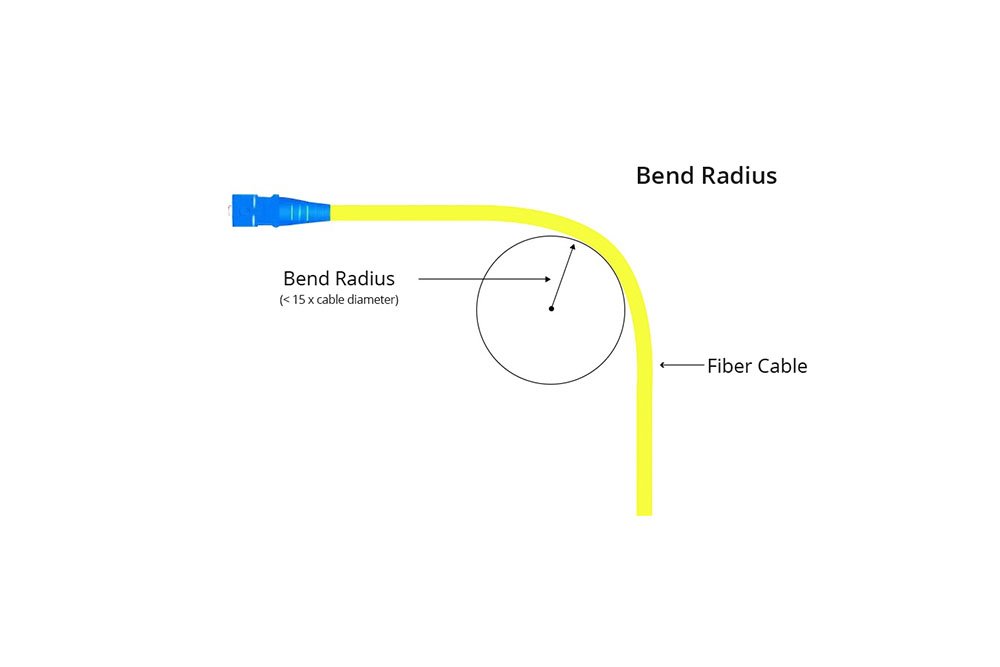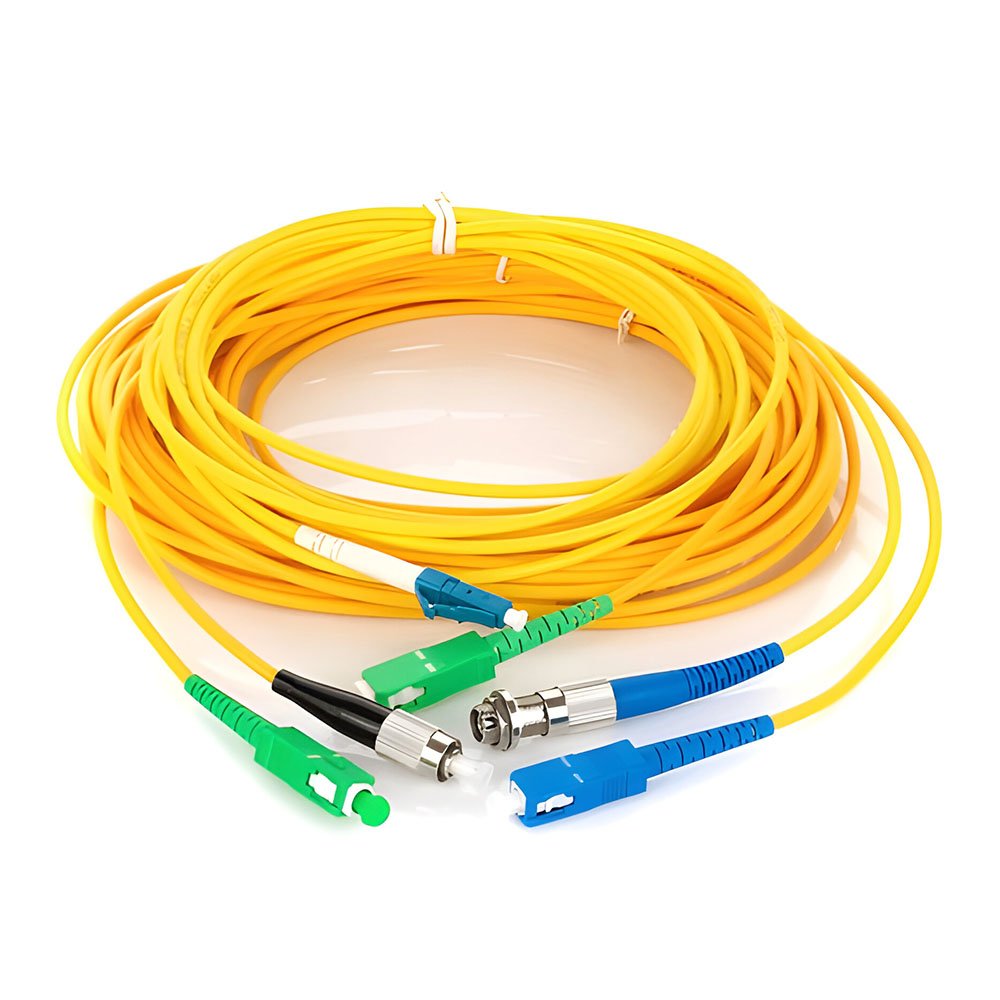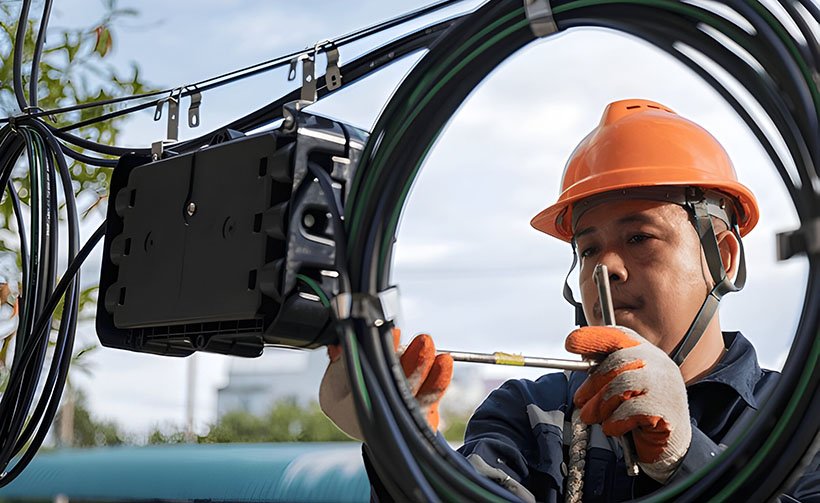Pagdating sa mga fiber optic cable, isa sa mga pinakamahalagang salik para sa pagtiyak ng maaasahang pagganap sa teknolohiya ng fiber optic ay ang pag-unawa sa konsepto ng fiber bending radius. Isipin ang pagbaluktot ng straw nang masyadong matalas—maaaring mabaluktot ito at hindi na gumana nang maayos. Katulad nito, baluktot a fiber optic cable Ang masyadong mahigpit ay maaaring makagambala sa mga light signal na dumadaan dito, na humahantong sa pagkawala ng data o pagkasira ng signal. Sa gabay na ito para sa baguhan, tuklasin natin kung ano fiber bending radius ay, kung bakit ito mahalaga sa pag-install ng fiber optic, kung paano ito nakakaapekto sa iba't ibang uri ng mga fiber optic cable, at mga praktikal na tip para sa pamamahala nito. Nagse-set up ka man ng home network o nagtatrabaho sa malakihan teknolohiya ng fiber optic proyekto, pag-unawa fiber bending radius ay susi upang mapanatiling mabilis at maaasahan ang iyong mga koneksyon. Sumisid tayo at lutasin ang mahalagang aspetong ito ng mga fiber optic cable!
Ano ang Fiber Bending Radius?

Pagtukoy sa Fiber Bending Radius
Ang fiber bending radius tumutukoy sa pinakamababang radius a fiber optic cable maaaring baluktot nang hindi nagdudulot ng pinsala o nakakaapekto sa pagganap nito. Isipin ito bilang ang pinakamaliit na bilog na maaari mong ibaluktot ang cable bago ito magsimulang magkaroon ng mga problema. Sa teknolohiya ng fiber optic, ang fiber bending radius ay sinusukat sa milimetro o sentimetro at nag-iiba depende sa uri ng fiber optic cable. Kapag a fiber optic cable ay baluktot na lampas sa pinakamababang radius na ito, ang mga ilaw na signal sa loob ay maaaring tumagas o magkalat, na humahantong sa pagkawala ng signal—kadalasang tinatawag na "pagkawala ng liko“—o kahit pisikal na pinsala sa hibla mismo.
Paano Ito Gumagana sa Fiber Optic Cable

Sa loob a fiber optic cable, ang liwanag ay naglalakbay sa isang glass o plastic core, na ginagabayan ng isang nakapalibot na cladding layer na may mas mababang refractive index. Pinapanatili ng setup na ito ang liwanag na tumatalbog sa loob ng core habang gumagalaw ito sa kahabaan ng fiber. Gayunpaman, kapag ang cable ay nakabaluktot nang masyadong mahigpit, ang ilaw ay hindi maaaring sumunod sa curve nang maayos. Ang ilan sa mga liwanag ay tumakas sa cladding o higit pa, na nagiging sanhi ng pagkawala ng lakas ng signal. Sa teknolohiya ng fiber optic, ang fiber bending radius ay isang kritikal na detalye dahil tinutukoy nito kung gaano kalaki ang baluktot ng cable bago maging makabuluhan ang pagkawalang ito. Nagbibigay ang mga tagagawa ng isang minimum fiber bending radius para sa bawat cable, kadalasang nakalista bilang multiple ng diameter ng cable—halimbawa, ang cable ay maaaring may minimum na bending radius na 10 beses sa diameter nito.
Bakit Ito ay Isang Pangunahing Detalye
Ang fiber bending radius ay isang pangunahing detalye sa pag-install ng fiber optic dahil ito ay direktang nakakaapekto sa pagiging maaasahan at kahusayan ng mga fiber optic cable. Kung baluktot mo nang napakabilis ang isang cable—sabihin, habang niruruta ito sa isang masikip na sulok sa isang data center—nanganganib mong masira ang signal, pabagalin ang paghahatid ng data, o kahit na masira ang fiber sa loob. Sa teknolohiya ng fiber optic, pag-unawa at paggalang sa fiber bending radius tinitiyak na ang iyong network ay gumaganap nang pinakamahusay, kung ikaw ay nagsi-stream ng mga video sa bahay o namamahala ng isang malaking telecom network.
Bakit Mahalaga ang Fiber Bending Radius
Epekto sa Kalidad ng Signal
Ang pangunahing dahilan fiber bending radius bagay sa teknolohiya ng fiber optic ang epekto nito sa kalidad ng signal. Kapag a fiber optic cable ay baluktot na lampas sa pinakamababa nito fiber bending radius, ang mga light signal na naglalakbay sa core ay maaaring makatakas, na humahantong sa isang phenomenon na tinatawag na bend loss. Ang pagkawalang ito ay nagpapahina sa signal, na maaaring magresulta sa mas mabagal na bilis ng data, bumaba ang mga koneksyon, o mga error sa paghahatid ng data. Halimbawa, sa isang high-speed na koneksyon sa internet, ang sobrang baluktot ay maaaring magdulot ng buffering sa panahon ng video streaming o pagkaantala sa isang video call. Sa pag-install ng fiber optic, tinitiyak na mananatili ang cable sa loob nito fiber bending radius Ang mga limitasyon ay mahalaga para sa pagpapanatili ng malinaw, maaasahang komunikasyon.
Panganib ng Pisikal na Pinsala
Baluktot a fiber optic cable ang masyadong mahigpit ay hindi lang nakakaapekto sa signal—maaari din itong magdulot ng pisikal na pinsala. Ang glass core sa loob mga fiber optic cable ay lubhang manipis at marupok, at baluktot ito nang higit sa inirerekomenda fiber bending radius maaaring lumikha ng mga micro-crack o kahit na masira ang hibla nang buo. Ang mga micro-crack na ito, kadalasang tinatawag na micro-bends, ay maaaring lumala sa paglipas ng panahon, na humahantong sa permanenteng pagkawala ng signal. Sa teknolohiya ng fiber optic, ang isang sirang hibla ay nangangahulugan na ang cable ay kailangang palitan, na maaaring magastos at matagal, lalo na sa malakihang pag-install ng fiber optic mga proyekto tulad ng mga kable sa ilalim ng dagat o mga network sa buong lungsod.
Pangmatagalang Pagkakaaasahan ng Fiber Optic Cable
Paggalang sa fiber bending radius tinitiyak din ang pangmatagalang pagiging maaasahan ng mga fiber optic cable. Kahit na ang isang cable ay hindi agad masira kapag nakabaluktot ng masyadong mahigpit, ang paulit-ulit na stress o maliit na micro-bends ay maaaring magpapahina sa pagganap nito sa paglipas ng panahon. Sa teknolohiya ng fiber optic, ang unti-unting pagkasira na ito ay maaaring humantong sa pagtaas ng mga gastos sa pagpapanatili at hindi inaasahang downtime ng network. Sa pamamagitan ng pagsunod sa inirerekomenda fiber bending radius habang pag-install ng fiber optic, maaari mong pahabain ang habang-buhay ng iyong mga fiber optic cable at panatilihing maayos ang iyong network sa loob ng maraming taon.
Fiber Bending Radius sa Iba't ibang Uri ng Fiber Optic Cable
Single-Mode Fiber at Bending Radius
Single-mode mga fiber optic cable ay idinisenyo upang magdala ng iisang light signal sa malalayong distansya, na ginagawa itong karaniwan sa mga telecom network at long-haul na koneksyon sa internet. Sa teknolohiya ng fiber optic, ang single-mode fibers ay may mas maliit na core—karaniwang nasa 8 hanggang 10 micrometers—na ginagawang mas sensitibo ang mga ito sa baluktot. Dahil sa mas maliit na core na ito, ang fiber bending radius para sa mga single-mode fibers sa pangkalahatan ay mas malaki, ibig sabihin, hindi sila maaaring baluktot nang mahigpit tulad ng iba pang mga uri ng fibers. Halimbawa, isang tipikal na single-mode fiber optic cable maaaring may minimum fiber bending radius ng 30 millimeters, o humigit-kumulang 10 hanggang 15 beses ang diameter nito, upang maiwasan ang makabuluhang pagkawala ng liko.

Multimode Fiber at Bending Radius
Multimode mga fiber optic cable maaaring magdala ng maraming light signal nang sabay-sabay, na ginagawang perpekto ang mga ito para sa mas maiikling distansya, tulad ng sa mga data center o local area network (LAN). Sa teknolohiya ng fiber optic, ang mga multimode fibers ay may mas malaking core—karaniwan ay 50 hanggang 62.5 micrometers—na ginagawang hindi gaanong sensitibo sa baluktot kumpara sa mga single-mode fibers. Bilang resulta, ang fiber bending radius para sa multimode mga fiber optic cable ay karaniwang mas maliit, na nagbibigay-daan para sa mas mahigpit na mga liko. Halimbawa, maaaring may minimum ang isang multimode cable fiber bending radius ng 15 millimeters, o mga 5 hanggang 10 beses ang diameter nito, depende sa partikular na disenyo ng cable.
Bend-Insensitive Fiber Optic Cable
Sa nakalipas na mga taon, teknolohiya ng fiber optic ay nagpakilala ng bend-insensitive mga fiber optic cable, na idinisenyo upang mahawakan ang mas mahigpit na mga liko nang walang makabuluhang pagkawala ng signal. Gumagamit ang mga cable na ito ng mga espesyal na disenyo ng core at cladding upang mapanatili ang mga light signal kahit na baluktot nang mas matindi ang cable. Sa pag-install ng fiber optic, ang mga bend-insensitive na cable ay kadalasang ginagamit sa mga masikip na espasyo—tulad ng mga apartment building o masikip na data center—kung saan hindi maiiwasan ang pagruruta ng mga cable sa mga sulok. Ang fiber bending radius para sa bend-insensitive mga fiber optic cable maaaring kasing baba ng 7.5 millimeters, o humigit-kumulang 2 hanggang 5 beses ang diameter ng cable, na ginagawang mas flexible ang mga ito habang pinapanatili pa rin ang performance.
Mga Praktikal na Alituntunin para sa Pamamahala ng Fiber Bending Radius
Sumusunod sa Mga Detalye ng Manufacturer
Ang una at pinakamahalagang patnubay para sa pamamahala fiber bending radius sa pag-install ng fiber optic ay sundin ang mga detalye ng tagagawa para sa iyong mga fiber optic cable. Ang bawat cable ay may kasamang datasheet na naglilista ng pinakamababa nito fiber bending radius, madalas na tinukoy para sa parehong panandaliang (sa panahon ng pag-install) at pangmatagalang (kapag na-install) na mga kondisyon. Halimbawa, maaaring pahintulutan ng cable ang mas mahigpit na liko habang nag-i-install—sabihin, 10 beses ang diameter nito—ngunit nangangailangan ng mas malaking radius, tulad ng 15 beses ang diameter nito, kapag naayos na ito upang maiwasan ang pangmatagalang stress. Palaging suriin ang mga detalyeng ito bago iruta ang iyong mga fiber optic cable upang matiyak na nasa loob ka ng ligtas na mga limitasyon.
Paggamit ng Wastong Cable Management Tools
Sa pag-install ng fiber optic, ang paggamit ng mga tamang tool ay makakatulong sa iyong pamahalaan fiber bending radius mabisa. Ang mga cable tray, conduit, at bend radius guide ay idinisenyo upang suportahan mga fiber optic cable at pigilan ang mga ito na maging masyadong mahigpit. Halimbawa, ang gabay sa bend radius ay maaaring isang curved plastic na piraso na ikinakabit mo sa isang sulok, na tinitiyak na ang cable ay sumusunod sa isang makinis at ligtas na curve. Sa teknolohiya ng fiber optic, ang mga tool na ito ay lalong mahalaga sa mga masikip na espasyo, tulad ng sa loob ng mga rack ng kagamitan o mga conduit sa dingding, kung saan ang mga cable ay mas malamang na mabaluktot nang husto.
Pag-iwas sa Mga Karaniwang Pagkakamali sa Baluktot
Mayroong ilang mga karaniwang pagkakamali na dapat iwasan habang pag-install ng fiber optic upang protektahan ang fiber bending radius. Una, huwag pilitin a fiber optic cable sa paligid ng isang matulis na sulok—laging gumamit ng unti-unting kurba. Pangalawa, iwasan ang pagtali ng mga cable nang masyadong mahigpit gamit ang mga zip ties, dahil maaari nitong kurutin ang cable at lumikha ng mga micro-bends. Pangatlo, maging maingat sa paghila ng mga cable sa mga conduit; ang sobrang pag-igting ay maaaring maging sanhi ng pagyuko ng cable nang masyadong matindi sa mga entry o exit point. Sa teknolohiya ng fiber optic, ang pagsasagawa ng mga pag-iingat na ito ay tumitiyak sa iyong mga fiber optic cable gumanap nang mapagkakatiwalaan nang walang pagkawala ng signal.
Fiber Bending Radius sa Real-World Applications
Pag-install ng Fiber Optic sa Mga Data Center
Sa mga data center, mga fiber optic cable kumonekta sa mga server, switch, at storage device, kadalasan sa napakaraming lugar. Sa pag-install ng fiber optic para sa mga data center, pamamahala fiber bending radius ay kritikal dahil ang mga cable ay madalas na dinadala sa masikip na espasyo, tulad ng sa ilalim ng sahig o sa loob ng mga rack ng kagamitan. Paggamit ng bend-insensitive mga fiber optic cable maaaring makatulong, dahil pinapayagan nila ang mas mahigpit na pagliko nang walang pagkawala ng signal. Gayunpaman, kahit na may mga cable na ito, dapat sundin ng mga installer ang wastong mga kasanayan sa pamamahala ng cable upang maiwasan ang paglampas sa fiber bending radius, tinitiyak na ang high-speed na paghahatid ng data ay nananatiling walang tigil.
Fiber Optic Technology sa Mga Setting ng Residential
Sa mga setting ng tirahan, teknolohiya ng fiber optic ay nagiging karaniwan para sa high-speed internet, kadalasang tinatawag na fiber-to-the-home (FTTH). Sa pag-install ng fiber optic para sa mga tahanan, mga fiber optic cable maaaring kailangang i-ruta sa mga dingding, sa paligid ng mga sulok, o sa likod ng mga kasangkapan. Ang fiber bending radius nagiging alalahanin sa mga masikip na espasyong ito, lalo na kung hindi maingat ang mga installer. Halimbawa, ang pagbaluktot ng cable nang masyadong matindi sa paligid ng doorframe ay maaaring magdulot ng pagkawala ng signal, na humahantong sa mas mabagal na bilis ng internet. Ang paggamit ng mga bend-insensitive na cable at wastong mga diskarte sa pagruruta ay nakakatulong na mapanatili ang pagganap sa mga sitwasyong ito.
Mga Network ng Telecom at Long-Haul na Koneksyon
Sa mga network ng telecom, mga fiber optic cable ay ginagamit para sa mga long-haul na koneksyon, tulad ng sa pagitan ng mga lungsod o sa mga karagatan. Sa teknolohiya ng fiber optic para sa mga application na ito, single-mode mga fiber optic cable ay karaniwan dahil sa kanilang kakayahang magpadala ng mga signal sa malalayong distansya. Gayunpaman, ang mga cable na ito ay may mas malaki fiber bending radius, na ginagawa silang mas sensitibo sa pagyuko. Sa panahon ng pag-install ng fiber optic, dapat tiyakin ng mga inhinyero ng telecom na ang mga cable ay inilatag na may banayad na mga kurba, kadalasang gumagamit ng malalaking conduit o aerial setup upang maiwasan ang masikip na baluktot, na tinitiyak ang integridad ng signal sa malalayong distansya.

Mga Hamon at Solusyon sa Pamamahala ng Fiber Bending Radius
Mga Hamon sa Masikip na Lugar
Isa sa mga pinakamalaking hamon sa pamamahala fiber bending radius ay nagtatrabaho sa mga masikip na espasyo, tulad ng sa loob ng mga cabinet ng kagamitan o sa pamamagitan ng makitid na mga conduit. Sa pag-install ng fiber optic, ang mga kapaligirang ito ay nagpapahirap sa pag-iwas sa matalim na pagliko, na nagdaragdag ng panganib ng pagkawala ng signal o pagkasira nito mga fiber optic cable. Halimbawa, sa isang napakaraming data center, maaaring may maliit na puwang upang iruta ang mga cable gamit ang inirerekomenda fiber bending radius, na humahantong sa mga potensyal na isyu sa pagganap.
Mga Solusyon: Mga Bend-Insensitive na Cable at Tool
Upang matugunan ang hamon na ito, teknolohiya ng fiber optic ay nakabuo ng bend-insensitive mga fiber optic cable, na kayang humawak ng mas mahigpit na pagliko nang walang makabuluhang pagkawala ng signal, gaya ng nabanggit kanina. Bukod pa rito, maaaring makatulong ang paggamit ng mga espesyal na tool tulad ng mga bend radius protector—maliliit na curved guide na pumipigil sa mga cable mula sa masyadong mabilis na pagyuko. Sa pag-install ng fiber optic, pagsasama-sama ng mga solusyong ito sa maingat na pagpaplano, tulad ng maagang pagmamapa ng mga ruta ng cable, na tinitiyak na ang fiber bending radius ay iginagalang kahit sa masikip na espasyo.
Pagsasanay at Kamalayan para sa mga Installer
Ang isa pang hamon ay ang pagtiyak na alam ng mga installer ang kahalagahan ng fiber bending radius. Sa teknolohiya ng fiber optic, hindi wastong paghawak habang pag-install ng fiber optic—tulad ng pagbaluktot ng mga kable nang masyadong mahigpit o paggamit ng labis na puwersa—ay maaaring humantong sa mga agaran o pangmatagalang isyu. Ang solusyon ay nasa wastong pagsasanay: ang mga installer ay dapat na turuan sa fiber bending radius mga pagtutukoy para sa mga fiber optic cable nagtatrabaho sila, pati na rin ang pinakamahuhusay na kagawian para sa pagruruta at pag-secure ng mga cable upang maiwasan ang mga pagkakamali sa pagbaluktot.
Konklusyon: Mastering Fiber Bending Radius para sa Mas Mahusay na Fiber Optic Performance
Ang konsepto ng fiber bending radius maaaring mukhang isang maliit na detalye, ngunit ito ay gumaganap ng isang malaking papel sa pagganap at pagiging maaasahan ng mga fiber optic cable. Sa pamamagitan ng pag-unawa kung ano fiber bending radius ay, kung bakit ito mahalaga, at kung paano pamahalaan ito, maaari mong tiyakin na ang iyong pag-install ng fiber optic—para sa bahay, data center, o telecom network—naghahatid ng mabilis, maaasahang koneksyon. Mula sa paggalang sa mga detalye ng tagagawa hanggang sa paggamit ng bend-insensitive mga fiber optic cable at wastong mga tool sa pamamahala ng cable, may mga praktikal na hakbang na maaari mong gawin upang maiwasan ang mga pitfalls ng labis na baluktot. Bilang teknolohiya ng fiber optic patuloy na umuunlad, na nananatiling maalalahanin fiber bending radius ay makakatulong sa iyo na masulit ang iyong mga fiber optic cable, pinapanatili ang iyong network na tumatakbo nang maayos sa mga darating na taon.

